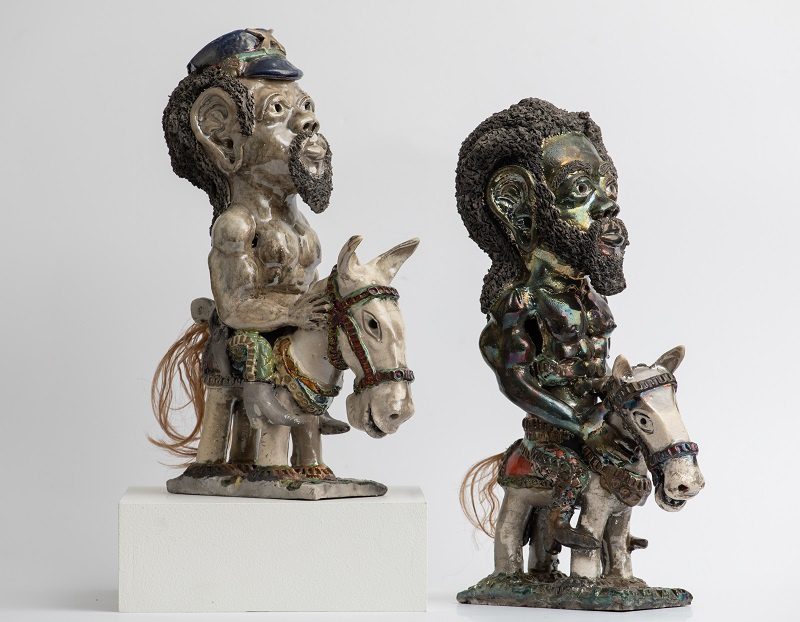The Crocker Art Museum, Sacramento, CA, United States
02 Feb 2020 - 05 Jul 2020

(left) Akinsanya Kambon, John Randall, Buffalo Soldier, 2012. Raku-fired clay, 15 1/2 x 4 x 9 1/2 in. Crocker Art Museum, long-term loan from Akinsanya D. Kambon aka Mark Teemer. (right) Akinsanya Kambon, Equestrian Black Sampson, 2012. Raku-fired clay, 16 1/2 x 5 1/4 x 10 in. Crocker Art Museum, gift of S. Tama-sha Ross Kambon and Akinsanya D. Kambon aka Mark Teemer, 2018.5.
The Crocker Art Museum presents “American Expressions/African Roots,” an exhibition of clay sculptures by Akinsanya Kambon, a former Marine, Black Panther, and art professor who uses the Western-style raku technique — a challenging, dangerous, and unpredictable process that creates prismatic and iridescent glaze finishes.
While the Sacramento-born artist’s work is as diverse as his personal history and is expressed through various media, this exhibition focuses entirely on his ceramics. Kambon performs his kiln firings in a ceremonial manner, breathing life into ceramic figures that typically represent African deities and spirits and, sometimes, American history and religious subjects. Drawing heavily on narrative tradition and personal experiences, including extensive travels throughout Africa, Kambon’s work celebrates perseverance through hardship, cultural pride, and his gift as a storyteller.
Born as Mark Teemer in 1946, Kambon was stricken with polio as a child. He turned to drawing for comfort, and ultimately his therapy. He recalls in his adolescence frequent visits to the Crocker Art Museum, which fascinated him and showed him the human potential in creating art. From 1966–1968, he served a tour of duty in Vietnam with the United States Marine Corps as a combat illustrator and infantryman. Shortly after returning home, he became Lieutenant of Culture for the Sacramento Chapter of the Black Panther Party and created “The Black Panther Coloring Book » to bring attention to racial inequality and social injustice. Despite being semi-literate in his youth, Kambon went on to earn his Master of Arts from California State University, Fresno.
Today, Kambon expresses his perspectives through drawings, paintings, bronze sculptures, and ceramics. He often performs his Western-style raku firings at night, in the company of dancers and drummers. Unlike traditional Japanese raku ware, which is removed from the kiln and cooled, Western-style raku ceramics are heated and placed directly into a sealed container with dry, combustible materials like newspaper, straw, leaves, and sawdust. The materials ignite and form a reduction atmosphere as the oxygen depletes within the container.
For Kambon, this process infuses each of his works with its “juju” or spiritual vigor. A particularly emotive example depicts Nehanda Charwe Nyakasikana (ca. 1840–1898), a woman known as the “Grandmother Healer” of the Zezuru Shona people of Zimbabwe. She is portrayed with a tormented expression of grief as she tries to resuscitate the lifeless body of a young child slumped in her arms. A notable military leader in the struggle against colonial forces, Nyakasikana was sentenced to death by hanging — an execution which failed repeatedly until the spiritual pouch she wore was removed. At this final hanging, she declared, “My bones will rise again!”
Other works in the exhibition include equestrian figures that combine American history with African sculptural tradition. There are also lidded vessels such as “The Greatest Shame,” which references the African slave trade and the devastating evils of pursing profit. On the side of this vessel, a man is guided by a turtle, an animal symbolizing wisdom. “We must follow the lead of the wisest among us or we will be guided down the wrong path,” explains the artist.
Kambon has long been an advocate for art and education. He worked as a professor at California State University, Long Beach, for 26 years. In 1984, still guided by the Black Panther Party’s principles of serving the community, he founded Pan African Art, a program that offers free art classes for children. In 1993, he was a recipient of the Community Fellowship Award from the California Wellness Foundation, which supported his efforts in community leadership and violence prevention. In 1995, the artist and his wife, S. Tama-sha Ross Kambon, co-founded Pan African Art, Inc., a nonprofit that promotes academic achievement, an understanding of history, leadership skills, and self-expression among youth through art. In 2003, they founded The Gallery Kambon and, in 2019, established the Pan African Art Museum in Long Beach. Kambon divides his time between studios in Long Beach and Sacramento, California, and actively continues his work today.
The Crocker Art Museum
216 O Street
Sacramento, CA 95814